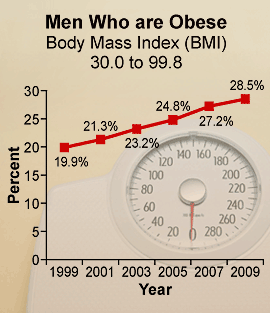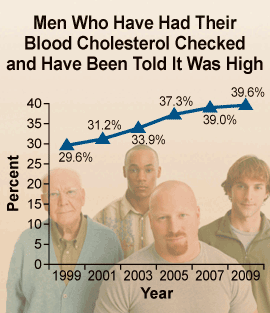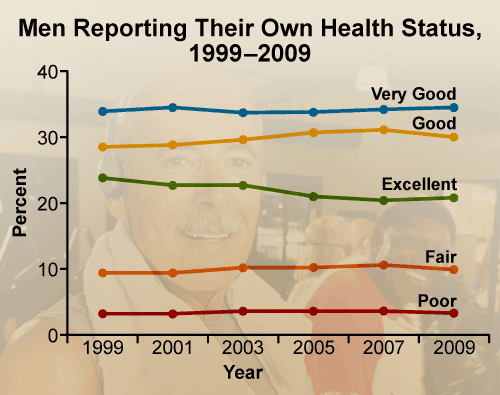U.S. Men Report: Changes in Self-Reported Health Behaviors and Chronic Conditions from 1999 to 2009
U.S. males should look for ways to make healthy choices in their daily lives, including increasing physical activity, practicing healthy eating, and reducing alcohol and tobacco use.


According to the U.S. Census Bureau, males make up 49.3% of the United States population. CDC's Behavioral Risk Factor Surveillance System (BRFSS) recently released 2009 data on U.S. adult health risks and behaviors. Self-reported health behaviors and chronic conditions for U.S. men fluctuated from 1999 to 2009. Among U.S. males, health behaviors for tobacco use and binge drinking decreased and chronic conditions including obesity, diabetes, and hypertension prevalence increased from 1999 to 2009.
Improved Health Behaviors
Improved self-reported health behaviors included smoking, binge drinking and exercise. Men who reported being current smokers dropped from 24.3% in 1999 to 19.6% in 2009, and those who reported binge drinking (five or more drinks on one occasion) declined from 23.9% in 1999 to 21.2% in 2009. Men who participated in moderate physical activity (30 or more minutes of moderate physical activity five or more days per week) increased from 49.7% in 2001 to 53.3% in 2009. Similarly, the percentage of men who did not participate in vigorous physical activity (20 or more minutes of vigorous physical activity three or more days per week) declined from 70.1% in 2001 to 65.3% in 2009. Also, men who reported themselves as overweight (having a Body Mass Index or BMI of 25.0 to 29.9) decreased from 45.3% in 1999 to 42.6% in 2009. Self-reported heart attacks declined slightly from 5.5% in 2005 to 5.2% in 2009. Angina or coronary heart disease also declined slightly from 5.2% in 2005 to 4.7% in 2009.
Worsened Health Behaviors
During the same time frame, worsened self-reported health behaviors include obesity, high cholesterol, diabetes, and hypertension (high blood pressure). Men who reported themselves as obese (having a Body Mass Index or BMI of 30.0 to 99.8) increased from 19.9% in 1999 to 28.5% in 2009. Men who have had their cholesterol checked and have been told that it was high increased from 29.6% in 1999 to 39.6% in 2009. Moreover, men who reported having diabetes increased from 5.9% in 1999 to 8.8% in 2009; and men who reported having hypertension increased from 23.0% in 1999 to 29.8% in 2009. The percentage of men who ate five or more servings of fruits and vegetables per day decreased slightly from 19.5% in 1999 to 19.1% in 2009.
About BRFSS
BRFSS is a state-based telephone health survey that collects information on health risk behaviors, preventive health practices, and health care access primarily related to chronic disease and injury. BRFSS data uses median values for state-by-state prevalence, or the number of existing cases in a defined group of people during a specific time period. For many states, BRFSS is the only available source of timely, accurate data on health-related behaviors. The Behavioral Risk Factor Surveillance System (BRFSS) is the world's largest, on-going telephone health survey system, tracking health conditions and risk behaviors in the United States yearly since 1984.
Currently data are collected monthly in all 50 states, the District of Columbia, Puerto Rico, the U.S. Virgin Islands, and Guam. More than 400,000 adults are interviewed each year. States use BRFSS data to identify emerging health problems, establish and track health objectives, and develop and evaluate public health policies and programs. Many states also use BRFSS data to support health-related legislative efforts.
Health Status Trends of U.S. Men from 1999 to 2009 (States and DC)
Men who are current smokers | Men who have had their blood cholesterol checked and have been told it was high |
|---|---|
2009 19.6 percent 2007 21.2 percent 2005 22.1 percent 2003 24.8 percent 2001 25.6 percent 1999 24.3 percent | 2009 39.6 percent 2007 39.0 percent 2005 37.3 percent 2003 33.9 percent 2001 31.2 percent 1999 29.6 percent |
Binge drinking-men | Men who have ever been told by a doctor |
2009 21.2 percent 2007 21.2 percent 2005 22.0 percent 2003 25.1 percent 2001 22.7 percent 1999 23.9 percent | 2009 8.8 percent 2007 8.1 percent 2005 7.7 percent 2003 7.2 percent 2001 6.6 percent 1999 5.9 percent |
Men who consumed five or more servings | Men who have ever been told by a doctor, nurse, or other health professional that they had high blood pressure |
2009 19.1 percent 2007 19.4 percent 2005 18.6 percent 2003 17.6 percent 2001 19.7 percent 1998 19.5 percent | 2009 29.8 percent 2007 28.1 percent 2005 25.4 percent 2003 25.1 percent 2001 25.2 percent 1999 23.0 percent |
Men who did not participate in Vigorous Physical Activity | Men who are Obese (BMI is 30.0 to 99.8) |
2009 65.3 percent 2007 67.1 percent 2005 68.0 percent 2003 68.5 percent 2001 70.1 percent 1999 N/A | 2009 28.5 percent 2007 27.2 percent 2005 24.8 percent 2003 23.2 percent 2001 21.3 percent 1999 19.9 percent |
Men who participated in Moderate Physical Activity | Men who have ever been told by a doctor, nurse, or health professional that that they had a heart attack (also called a myocardial infarction) |
2009 53.3 percent 2007 51.5 percent 2005 50.7 percent 2003 50.1percent 2001 49.7 percent 1999 N/A | 2009 5.2 percent 2007 5.4 percent 2005 5.5 percent 2003 N/A 2001 N/A 1999 N/A |
Men who are Overweight (BMI is 25.0 to 29.9) | Men who have ever been told by a doctor, nurse |
2009 42.6 percent 2007 43.1 percent 2005 43.7 percent 2003 44.0 percent 2001 44.8 percent 1999 45.3 percent | 2009 4.7 percent 2007 5.1 percent 2005 5.2 percent 2003 N/A 2001 N/A 1999 N/A |
Data Source: CDC's Behavioral Risk Factor Surveillance System (BRFSS): http://apps.nccd.cdc.gov/BRFSS/

More Information
- BRFSS
- CDC's Men's Health
- CDC Feature: Get Smart with Fruits and Veggies!
- Activity into Your Life, Your Way
- Listen to "Binge Drinking is Dangerous" in A Cup of Health with CDC [PODCAST - 4:36 minutes]
- Listen to "A Minute of Health with CDC" [PODCAST - 0:59 seconds]
- Send a Health-e-Card about Men's Health
Get email updates
To receive email updates about this page, enter your email address:
Contact Us:
- Centers for Disease Control and Prevention
1600 Clifton Rd
Atlanta, GA 30333 - 800-CDC-INFO
(800-232-4636)
TTY: (888) 232-6348 - Contact CDC-INFO







